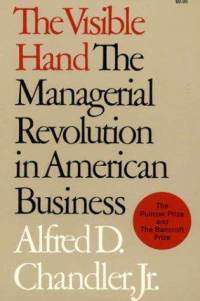The Visible Hand: The Managerial Revolution in American Business
 | |
| Author | Alfred D. Chandler, Jr. |
|---|---|
| Country | US |
| Genre | history |
| Publisher | Harvard University Press |
Publication date | 1977 |
| Pages | 608 |
| Awards | Pulitzer Prize for History |
| ISBN | 9780674940529 |
The Visible Hand: The Managerial Revolution in American Business is a book by American business historian Alfred D. Chandler, Jr., published by Harvard University Press in 1977. Chandler argues that in the nineteenth century, Adam Smith's famous invisible hand of the market was supplanted by the "visible hand" of middle management, which became "the most powerful institution in the American economy".[1]
The Visible Hand was awarded the 1978 Pulitzer Prize for History and the Bancroft Prize of Columbia University.[2]
Chandler's eight propositions
Chandler uses eight propositions[3] to show how and why the visible hand of management replaced what Adam Smith referred to as invisible hand of the market forces:
- that the US modern multi-unit business replaced small traditional enterprise, when administrative coordination permitted better profits than the coordination by market mechanism;
- that a managerial hierarchy have been created for this multi-unit business enterprise;
- that multi-unit business enterprise appeared for the first time in history in a time when the volume of economic activities reached a level that made administrative coordination more efficient than market coordination;
- that once a managerial hierarchy has been created and had successfully carried out its functions of administrative coordination, the hierarchy itself became a source of power, permanence and continued growth;
- that the careers of the salaried managers became increasingly professional and technical;
- that the multi-unit business enterprise grew in size and diversity and as its managers became more professional, the management of the enterprise became separated from its ownership;
- that managers preferred policies that favored long term stability and growth of their enterprises to those that maximized current profits;
- that as the large enterprises grew and dominated major sectors of the economy they altered the basic structure of these sectors and of the economy as a whole.
See also
References
- ↑ "Harvard Business School Professor Alfred D. Chandler, Jr., Preeminent Business Historian, Dead at 88". AScribe – via HighBeam Research (subscription required) . May 11, 2007. Retrieved December 9, 2012.
- ↑ "Noted Economic Historian Alfred Chandler Jr., 88". The Washington Post. – via HighBeam Research (subscription required) . May 14, 2007. Retrieved December 9, 2012.
- ↑ Chandler, Alfred. The Visible Hand. Belknap Press, 1977. ISBN 978-0674940529. Introduction.
Further reading
- Antonio, Robert J. "The Visible Hand: The Managerial Revolution in American Business." Telos 1979.42 (1979): 188-193.
- Hensel, Nayantara. "The Visible Hand: The Managerial Revolution in American Business." Defense A R Journal 19.3 (2012): 345+. Academic OneFile. Web.
- John, Richard R. "Elaborations, Revisions, Dissents: Alfred D. Chandler, Jr.'s, The Visible Hand After Twenty Years." Business History Review 71#2 (1997): 151-200. online
External links
This article is issued from Wikipedia - version of the 3/31/2016. The text is available under the Creative Commons Attribution/Share Alike but additional terms may apply for the media files.